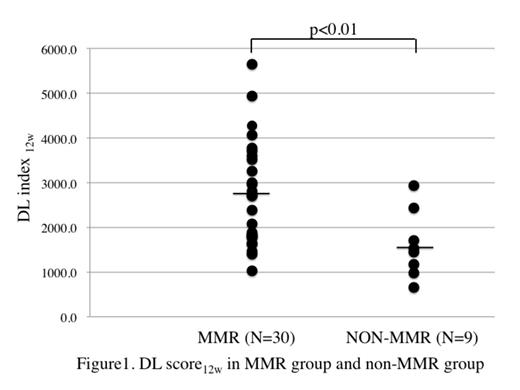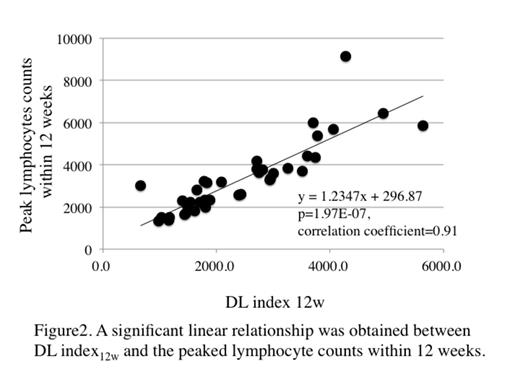Abstract
BACKGROUND: Dasatinib is a second-generation BCR-ABL inhibitor that has a 325-fold higher potency than imatinib and a 16-fold higher potency than nilotinib in vitro. Recent reports suggested that absolute lymphocytosis in response to dasatinib for chronic phase (CP) –chronic myeloid leukemia (CML) might be associated with favorable response. However, as the fluctuation of lymphocytosis was often observed, it is sometimes difficult to define lymphocytosis. To evaluate how much increase and how long continuation of lymphocytosis affects the better clinical efficacy, we developed an index (DL index; Dasatinib induced Lymphocytosis index) that combines duration and increase of lymphocytosis. The aim of this study was to test the DL index as a predictor of Major Molecular Response (MMR) at 12 month.
PATIENTS and METHODS: The DL area was based on a graph plotting the absolute lymphocyte counts and was the area under the lymphocyte curve using trapezoidal method. DL index was DL area divided by weeks. For example, DL index12W was defined as (DL area from 4 to 12 weeks) divided by (12-4) weeks. We tested the DL index12W in 30 patients who developed MMR at 12 months (MMR group) and 9 patients without MMR (non-MMR group).
RESULTS and DISCUSSION: DL score12w in MMR group and non-MMR group were 2714.0 (95% CI; 2286.0-3142.2, n=30) and 1559.9 (95% CI; 1006.9- 2113.0, n=9) respectively. There was a significant difference between MMR group and non-MMR group in DL index12W by t-test(Figure 1, p=0.0016). A significant linear relationship was obtained between DL index12w and the peaked lymphocyte counts within 12 weeks by Spearman's correlation coefficient rank test (Figure 2, p=1.97E-07, correlation coefficient=0.91).
The DL index12w, 2,113, which was the upper limit of non-MMR group 95% CI, is equivalent to 2,909/µl in lymphocyte count, and the DL index12w, 2,286, which is the lower limit of MMR group 95% CI, equivalent to 3,123/µl in lymphocyte count. Therefore, we divided all patients (n=39) into two groups, equal or more than 3,123/µl and less than 3,123/µl in the peaked lymphocyte counts. The patients with the peaked lymphocyte counts ≥ 3,123/µl reached MMR at 12 months (19/20=95.0%) to compare those less than 3,123/µl (11/19=57.9%) (p=0.0075).
CONCLUSION: The peaked lymphocyte number, induced by the DL index12w, which calculation was extremely easy, was associated with molecular response. These data suggests that this tool can be useful in interpreting the results of molecular response at 12 months.
No relevant conflicts of interest to declare.
Author notes
Asterisk with author names denotes non-ASH members.



This feature is available to Subscribers Only
Sign In or Create an Account Close Modal